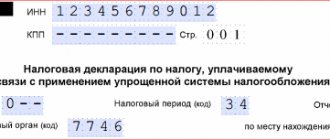The so-called Concept of the planning system for on-site tax audits was approved by order of the Federal Tax Service of Russia dated May 30, 2007 No. MM-3-06/333. It allows you to understand to what extent your business is at risk of being subject to an on-site audit by tax authorities. One of the main criteria is the tax burden by type of economic activity. In mid-May 2021, the Russian Tax Service published updated indicators of the tax burden by type of economic activity for 2017. We provide a complete list of them in this review (can be downloaded) so that each company (IP) can compare them with its value.
Also see “Safe profitability indicators by type of economic activity for 2017”.
Composition of activities
Traditionally, indicators of the tax burden by type of economic activity are fixed in Appendix No. 3 to the mentioned order. Now - for 2021 (the Federal Tax Service updates them annually). The document deals with enlarged areas of activity according to the OKVED-2 classifier. Look for the one that best suits your field.
Also see “On-site tax audit period: what they will come to see.”
Why do you need to know the tax burden “in person”?
Let's start by answering the main question: why, that is, for the industry and the market as a whole, is there a tax burden?
The first-order answer is obvious - to better understand the industry environment and your place in it. However, there is also a second-order reason - it is the average industry tax burden that the fiscal authorities look at when assessing a company as a respectable or dishonest payer. Deviation from the benchmark can cause unpleasant consequences for the company.
The tax burden is one of the key markers for the Federal Tax Service when deciding to conduct an on-site tax audit. In the list of 12 reasons for an on-site tax audit, low tax burden is among the first.
During the coronavirus pandemic, a moratorium has been imposed on on-site tax audits. According to Decree of the Government of the Russian Federation dated May 30, 2020 No. 792, the moratorium is valid until June 30. The further situation is difficult to predict; perhaps the moratorium will be extended, but there is a good chance that it will end soon. This means that the company’s tax burden will be examined by the Federal Tax Service “under a microscope.” If it does not correspond to the industry average, the likelihood of personal and lengthy communication with the tax inspector increases sharply.
Types of indicators
Note that the tax burden coefficients by type of economic activity in the Concept of on-site inspections of the Federal Tax Service are always presented in tabular form. And there are 2 types of them:
- just the tax burden;
- and for reference – the fiscal burden on insurance premiums.
Please note that the tax burden by type of economic activity for 2021 is shown as a percentage.
The tax burden is the ratio of taxes (including personal income tax) and fees according to the official statistical reporting of the Federal Tax Service of Russia to the turnover of organizations according to Rosstat, multiplied by 100%.
Below is a complete official list of tax burden indicators by type of economic activity for 2021 for the period 2021.
| Type of economic activity (according to OKVED-2) | Period 2021 | |
| The tax burden, % | For reference: fiscal burden for the North, % | |
| TOTAL | 10,8 | 3,6 |
| Agriculture, forestry, hunting, fishing, fish farming - total | 4,3 | 5,5 |
| crop and livestock farming, hunting and provision of related services in these areas | 3,5 | 5,4 |
| forestry and logging | 7,5 | 6,8 |
| fishing, fish farming | 7,9 | 5,5 |
| Mining - total | 36,7 | 1,8 |
| extraction of fuel and energy minerals - total | 45,4 | 1,0 |
| extraction of mineral resources, except fuel and energy | 18,8 | 4,1 |
| Manufacturing industries – total | 8,2 | 2,2 |
| production of food, beverages, tobacco products | 28,2 | 2,4 |
| production of textiles, clothing | 8,1 | 4,2 |
| production of leather and leather products | 7,9 | 4,7 |
| wood processing and production of wood and cork products, except furniture, production of straw products and wicker materials | 2,0 | 3,6 |
| production of paper and paper products | 4,4 | 1,8 |
| printing and copying activities | 9,2 | 4,3 |
| production of coke and petroleum products | 5,1 | 0,2 |
| production of chemicals and chemical products | 1,9 | 2,4 |
| production of medicines and materials used for medical purposes | 6,9 | 3,0 |
| production of rubber and plastic products | 6,3 | 2,6 |
| production of other non-metallic mineral products | 8,9 | 3,5 |
| metallurgical production and production of finished metal products, except machinery and equipment | 4,4 | 2,4 |
| production of machinery and equipment, not included in other groups | 8,8 | 3,9 |
| production of electrical equipment, production of computers, electronic and optical products | 9,9 | 4,3 |
| production of computers, electronic and optical products | 12,5 | 5,3 |
| production of electrical equipment | 6,7 | 3,0 |
| production of other vehicles and equipment | 4,7 | 4,8 |
| production of motor vehicles, trailers and semi-trailers | 5,1 | 1,7 |
| Providing electricity, gas and steam; air conditioning – total | 6,8 | 2,4 |
| generation, transmission and distribution of electricity | 8,1 | 2,2 |
| production and distribution of gaseous fuels | 1,3 | 1,4 |
| production, transmission and distribution of steam and hot water; air conditioning | 6,5 | 4,5 |
| Water supply, sanitation, organization of waste collection and disposal, activities and elimination of pollution - total | 8,4 | 4,8 |
| Construction | 10,2 | 4,3 |
| Wholesale and retail trade; repair of vehicles and motorcycles – total | 3,2 | 1,2 |
| Wholesale and retail trade in motor vehicles and motorcycles and their repair | 2,7 | 1,1 |
| wholesale trade, except wholesale trade of motor vehicles and motorcycles | 3,1 | 0,9 |
| retail trade, except trade in motor vehicles and motorcycles | 3,6 | 2,2 |
| Activities of hotels and catering establishments – total | 9,5 | 5,7 |
| Transportation and storage – total | 6,8 | 4,8 |
| railway transport activities: intercity and international passenger and freight transportation | 8,5 | 6,8 |
| pipeline transport activities | 4,5 | 2,1 |
| water transport activities | 9,3 | 4,1 |
| air and space transport activities | neg. | 3,0 |
| postal and courier activities | 14,4 | 11,6 |
| Activities in the field of information and communication - total | 16,4 | 5,2 |
| Real estate activities | 21,3 | 6,3 |
| Administrative activities and related additional services | 15,4 | 9,2 |
The source of information on the tax burden by type of economic activity for 2021 is the official website of the Federal Tax Service of Russia.
You can download free of charge indicators of the tax burden by type of economic activity for 2021 from our website via a direct link here.
Read also
17.05.2018
How to calculate the tax burden.
The algorithm for calculating the tax burden is as follows: the amount of taxes and fees for a calendar year accrued according to the reporting data of an enterprise or individual entrepreneur is divided by the annual turnover of the enterprise or individual entrepreneur according to accounting records. The resulting figure is multiplied by 100%, since the calculation is carried out as a percentage (%).
An important nuance: for the calculation, accrued taxes are taken for the year, not paid. Part of the payment may follow next year; accordingly, the tax burden will be underestimated, so it is the absolute indicator that is taken into account.
Data on accrued taxes are taken from tax returns. Taxes of individuals that an organization or individual entrepreneur charges as their tax agent, such as personal income tax, are also taken into account. At the same time, insurance premiums for employees are not taken into account, despite the fact that from 2021 they are transferred to the area of responsibility of the tax service. Also, contributions to all extra-budgetary funds are not taken into account, because they are not included in the list of taxes regulated by the tax code.
Let's calculate the tax burden using an example. Yarilo LLC produces electrical equipment. The tax burden for this industry based on industry average data for 2021 was 7.5%. The company's revenue for the year is 100 million rubles. Income tax – 3.8 million rubles, VAT – 2 million rubles, property tax – 1.5 million rubles, transport tax – 0.3 million rubles. We calculate the tax burden of the company: (3.8 million rubles + 2 million rubles + 1.5 million rubles + 0.3 million rubles): 100 million rubles. x 100%.. Result: 7.6%. The tax burden is slightly higher than the industry average. Conclusion: the taxpayer need not worry; the difference of 0.1% is not significant. Moreover, it is “a plus”.
What worries the Federal Tax Service
The salary level according to OKVED shows the capabilities of the industry. The more money can be earned, the more money organizations can allocate to payroll. Accordingly, more taxes will go to the budget.
The Federal Tax Service, in its Order No. MM-3-06/ [email protected] dated May 30, 2007, explains how it plans on-site inspections. In Appendix 2, the agency provides risk criteria, that is, those that are more likely to attract the attention of inspectors.
And number five is the criterion that the average monthly wage per employee is below the industry average. In accordance with the same paragraph, having discovered such a feature in an organization, the Federal Tax Service will take a closer look at it. First of all, it will check whether there have been complaints about salaries “in envelopes” and about employment without proper registration.
For specific taxes
Letter No. AS-4-2/12722 presents calculation formulas for types of tax burden for income taxes and VAT.
NN for income tax is determined by the formula: NNpr = Profit tax / (revenue from sales + non-operating income) * 100% The indicator is considered low if it does not exceed 3% for production and 1% for trade organizations.
Tax base for VAT is calculated as follows: Tax base tax = VAT payable/NB*100% The concept of tax base (TB) is defined as the amount of NB defined in sections 3 and 4 of the declaration. It is important that the tax agent’s VAT is not included in the calculation, since it is not included in the final amount payable in accordance with the rules for filling out a VAT return.
There is another way to calculate tax invoice for VAT: NNVAT = amount of VAT deductions/amount of accrued VAT*100% The amount of deductions and accrued VAT must be taken for the previous 4 quarters. The VAT tax should not be lower than 89% (Letter No. AS-4-2/12722).
LEGAL ASPECTS OF CONTROL OF THE TAX BURDEN OF A COMPANY
The concept of tax burden can be viewed in several directions. For business owners, the tax burden most often means the ratio of the amount of taxes accrued for the reporting period to the amount of profit, which shows what part of the income the company gives to the state.
For the purposes of planning the company's performance, the tax burden is equal to the sum of the products of the rate of taxes established by law by the amount of the taxable base for each tax.
The state, represented by the tax inspectorate, considers the tax burden as an indicator on the basis of which it can be concluded whether a company is using certain tax evasion schemes and whether this company needs to be included in the on-site inspection plan. Let's consider the tax burden from the point of view of the mechanism of control over the company's business by the tax inspectorate.
Back in 2007, the Concept of a planning system for on-site tax audits[1] was approved, which defined the value of a company’s tax burden as a publicly available criterion for independent risk assessment for taxpayers, used by tax authorities in the process of selecting objects for on-site tax audits. In accordance with this Concept, one of the grounds for ordering an on-site audit is “the tax burden of a given taxpayer is below its average level for business entities in a particular industry (type of economic activity).
In 2012, by Order of the Federal Tax Service of Russia dated May 10, 2012 No. ММВ-7-2/ [email protected] it was established that Appendix 3 of the Concept, containing indicators of the total tax burden for sectors of the national economy and the country as a whole, is annually updated with data no later than May 5 over the past year. For example, indicators for 2021 are shown in table. 1.
Table 1
Tax burden by type of economic activity in 2019*
| For reference: The tax burden is calculated as the ratio of the amount of taxes and fees according to the official statistical reports of the Federal Tax Service of Russia to the turnover of organizations according to Rosstat, multiplied by 100% | ||
| Type of economic activity (according to OKVED-2) | 2019 | |
| The tax burden, % | For reference: fiscal burden for SV**, % | |
| TOTAL | 11,2 | 3,5 |
| Agriculture, forestry, hunting, fishing, fish farming - total | 4,5 | 5,2 |
| crop and livestock farming, hunting and provision of related services in these areas | 3,4 | 4,8 |
| forestry and logging | 8,7 | 7,6 |
| fishing, fish farming | 10,1 | 6,0 |
| Mining - total | 41,4 | 1,7 |
| extraction of fuel and energy minerals - total | 50,9 | 1,1 |
| extraction of mineral resources, except fuel and energy | 11,4 | 3,6 |
| Manufacturing industries - total | 7,6 | 2,1 |
| production of food, beverages, tobacco products | 20,9 | 2,1 |
| production of textiles, clothing | 8,0 | 4,3 |
| production of leather and leather products | 10,0 | 5,3 |
| wood processing and production of wood and cork products, except furniture, production of straw products and wicker materials | 1,6 | 3,6 |
| production of paper and paper products | 4,8 | 1,9 |
| printing and copying activities | 8,9 | 3,8 |
| production of coke and petroleum products | 4,2 | 0,2 |
| production of chemicals and chemical products | 3,0 | 2,3 |
| production of medicines and materials used for medical purposes | 6,9 | 3,1 |
| production of rubber and plastic products | 6,9 | 2,8 |
| production of other non-metallic mineral products | 9,3 | 3,4 |
| metallurgical production and production of finished metal products, except machinery and equipment | 4,0 | 2,1 |
| production of machinery and equipment, not included in other groups | 9,9 | 4,4 |
| production of computers, electronic and optical products | 11,7 | 5,1 |
| production of electrical equipment | 7,5 | 3,3 |
| production of other vehicles and equipment | 6,5 | 4,7 |
| production of motor vehicles, trailers and semi-trailers | 5,8 | 1,5 |
| Providing electricity, gas and steam; air conditioning - total | 7,1 | 2,4 |
| generation, transmission and distribution of electricity | 8,3 | 2,1 |
| production and distribution of gaseous fuels | 1,3 | 1,7 |
| production, transmission and distribution of steam and hot water; air conditioning | 7,1 | 4,6 |
| Water supply, sanitation, organization of waste collection and disposal, activities and elimination of pollution - total | 9,9 | 5,1 |
| Construction | 11,9 | 4,7 |
| Wholesale and retail trade; repair of vehicles and motorcycles - total | 2,8 | 1,1 |
| Wholesale and retail trade in motor vehicles and motorcycles and their repair | 2,9 | 1,0 |
| wholesale trade, except wholesale trade of motor vehicles and motorcycles | 2,5 | 0,8 |
| retail trade, except trade in motor vehicles and motorcycles | 3,7 | 2,1 |
| Activities of hotels and catering establishments - total | 10,5 | 6,2 |
| Transportation and storage - total | 6,4 | 4,6 |
| railway transport activities: intercity and international passenger and freight transportation | 7,3 | 6,6 |
| pipeline transport activities | 6,1 | 2,2 |
| water transport activities | 8,3 | 4,2 |
| postal and courier activities | 15,9 | 11,6 |
| Activities in the field of information and communications - total | 17,2 | 5,5 |
| Real estate activities | 25,0 | 6,0 |
| Administrative activities and related additional services | 17,9 | 10,0 |
Notes:
* Including personal income tax amounts.
** SV - insurance contributions to extra-budgetary funds.
Letter No. AS-4-2/12722 of the Federal Tax Service of Russia dated July 17, 2013 “On the work of tax authorities’ commissions on the legalization of the tax base” approved formulas for calculating the tax burden in relation to some specific taxes and certain types of tax regimes. From July 25, 2017, the Letter of the Federal Tax Service of Russia “On the work of the commission for the legalization of the tax base and the base for insurance premiums” dated July 25, 2017 No. ED-4-15 / [email protected] additionally regulates the work procedure of the relevant commissions conducting an analysis of the dynamics during this work those indicators of taxpayers’ economic activities on which the level of their tax burden depends. Formulas for calculating the tax burden, similar to those contained in letter No. AS-4-2/12722, are also given here (in Appendix 7).
Note!
The above documents have lost force, but the Federal Tax Service continues to calculate the tax burden precisely according to the formulas contained in them. In addition, the online service on the tax service website also works according to these formulas.
Now on the website of the Federal Tax Service of Russia there is a special online service for calculating the tax burden of companies and individual entrepreneurs. Using this service, any taxpayer can independently assess how much their taxes correspond to those of similar businesses in their region.
To get information:
METHODOLOGY FOR CALCULATING THE TAX BURDEN OF A COMPANY
The tax burden is calculated both for the company as a whole and for different types of taxes separately.
The total tax burden is calculated using the formula:
Total tax burden = Amount of accrued taxes according to declarations (calculations) / Amount of revenue on line 2110 of the Profit and Loss Statement × 100%.
Note!
The Order of the Federal Tax Service No. MM-3-06 / [email protected] provides the following definition of calculation: the total tax burden is the ratio of the amount of taxes accrued according to tax declarations to revenue determined according to Goskomstat data (i.e. according to the income statement , without VAT).
In letters from the Ministry of Finance of Russia dated January 11, 2017 No. 03-01-15/208 and the Federal Tax Service dated March 22, 2013 No. ED-3-3/ [email protected] there are recommendations for calculations:
• the calculation includes all amounts of fiscal payments that were accrued by the taxpayer in the reporting period;
• the calculation takes into account payments that the company pays as a tax agent (for example, personal income tax for employees);
• the amount of accrued insurance contributions to extra-budgetary funds is not included in the calculation;
• amounts of import VAT are excluded from the calculation;
• the calculation does not take into account customs duties paid under current legislation.
For self-control, taxpayers can calculate the tax burden themselves. There are two calculation options:
1. Calculation of the tax burden for income tax:
Tax burden for income tax = Amount of calculated income tax (line 180 of sheet 02 of the annual income tax return) / Amount of income from sales and non-operating income (lines 010 and 020 of sheet 02 of the annual income tax return).
For the Federal Tax Service, a signal to initiate an on-site inspection may be an indicator value of less than 3% for manufacturing companies and less than 1% for trading enterprises.
2. Calculation of the tax burden for value added tax:
Tax burden for VAT = Amount of VAT deductions / Amount of accrued VAT × 100%.
Here, for the Federal Tax Service, an alarming signal will be a figure of 89% or more.
Table 2 presents calculations of the tax burden for the most common types of taxes.
Fiscal burden on SV - what is it?
The tax burden is understood as the relative amount of resources diverted by a business entity from circulation to pay tax obligations to the budget. This indicator allows you to assess the level of influence of taxes on the current profitability of activities. The fiscal burden can be derived using different parameters:
- for the state as a whole;
- broken down by constituent entities of the Russian Federation;
- by sectors of business activity;
- by categories of enterprises grouped according to homogeneous characteristics;
- for individual business entities or individuals.
The basis for assessing the level of tax pressure can be, inter alia, accrued and paid insurance premiums. The absolute and relative value of the tax burden is required for an objective analysis of the enterprise’s activities and the drawing up of a plan of inspection activities by regulatory authorities. This parameter allows business entities to assess the level of tax risks.





